Insights on the Influence of Surface Chemistry and Rim Zone Microstructure of 42CrMo4 on the Efficiency of ECM
Abstract
1. Introduction
2. Materials and Methods
2.1. Materials
2.2. The Experimental Test of ECM
2.3. Chemical Analysis of the Electrolyte before and after ECM
2.4. Scanning Electron Microscopy and Electron Backscatter Diffraction
2.5. Rim Zone Analysis of the Native Oxide and the Oxide after ECM Processing
3. Results
3.1. Microstructure
3.2. Electrochemical Machining
3.3. Surface Analysis after ECM
4. Discussion
5. Conclusions
- An increase in the current density in the ECM process from about 20 to 34 A/cm2 leads to a change of the composition and stoichiometry of the transpassively formed Fe3-xO4 mixed oxide layer on the material surface. The proportion of Fe2O3 in the oxide layer increases with increasing current density. Simultaneously, an increase in process efficiency can also be observed. This is partially attributed to the local composition of the mixed oxide. Fe2O3 which preferentially forms at high current densities is electrically less conductive than Fe3O4 forming at low current densities. Since the charge-consuming oxygen evolution occurs preferentially on surfaces with good electrical conductivity, it is assumed that oxygen evolution tends to decrease with increasing Fe2O3 content in the rim zone. This has a positive effect on the efficiency of the ECM process.
- The microstructure of the material exhibits a significant influence on the efficiency of material removal. The efficiency of material removal of martensitic 42CrMo4 is about 10% higher compared to ferritic–pearlitic 42CrMo4. This is predominantly attributed to the presence of cementite lamellae in the ferritic–pearlitic microstructure, which accumulate on the surface during the ECM by selective dissolution of the ferritic phase. The undesirable reaction of oxygen evolution takes place preferentially on cementite, which has a negative effect on the charge yield and thus the efficiency of the process.
Author Contributions
Funding
Institutional Review Board Statement
Informed Consent Statement
Data Availability Statement
Acknowledgments
Conflicts of Interest
References
- Yang, Y.; Zhu, D.; Lu, J. Surface Morphology Analysis of 1Cr11Ni2W2MoV Steel Subjected to Electrochemical Machining in NaNO3 Solution. J. Electrochem. Soc. 2020, 167, 043504. [Google Scholar] [CrossRef]
- Klocke, F.; Zeis, M.; Klink, A. Interdisciplinary modelling of the electrochemical machining process for engine blades. CIRP Ann. 2015, 64, 217–220. [Google Scholar] [CrossRef]
- Zhao, Z.Q.; Ma, Z.G.; Liu, Y.T.; Wu, X.L.; Guo, H. Optimization and Affections of Cathode Feed Angle on Machining Accuracy Error Distribution of Aero-Engine Blade in Electrochemical Machining. Key Eng. Mater. 2018, 764, 225–234. [Google Scholar] [CrossRef]
- Tang, Y.; Xu, Z. The electrochemical dissolution characteristics of GH4169 nickel base super alloy in the condition of electrochemical machining. Int. J. Electrochem. Sci. 2018, 13, 1115–1119. [Google Scholar] [CrossRef]
- Wang, D.; He, B.; Cao, W. Enhancement of the localization effect during electrochemical machining of inconel 718 by using an alkaline solution. Appl. Sci. 2019, 9, 690. [Google Scholar] [CrossRef]
- Schubert, N.; Schneider, M.; Michaelis, A.; Manko, M.; Lohrengel, M.M. Electrochemical machining of tungsten carbide. J. Solid. State. Electrochem. 2018, 22, 859–868. [Google Scholar] [CrossRef]
- Kamaraj, A.B.; Sundaram, M.M.; Mathew, R. Ultra high aspect ratio penetrating metal microelectrodes for biomedical applications. Microsyst. Technol. 2013, 19, 179–186. [Google Scholar] [CrossRef]
- Haisch, T.; Mittemeijer, E.; Schultze, J.W. Electrochemical machining of the steel 100Cr6 in aqueous NaCl and NaNO3 solutions: Microstructure of surface films formed by carbides. Electrochim. Acta 2001, 47, 235–241. [Google Scholar] [CrossRef]
- Klocke, F.; Harst, S.; Ehle, L.; Zeis, M.; Klink, A. Surface integrity in electrochemical machining processes: An analysis on material modifications occurring during electrochemical machining. Proc. Inst. Mech. Eng. Part B J. Eng. Manuf. 2018, 232, 578–585. [Google Scholar] [CrossRef]
- Rajurkar, K.P.; Sundaram, M.M.; Malshe, A.P. Review of electrochemical and electrodischarge machining. Procedia Cirp. 2013, 6, 13–26. [Google Scholar] [CrossRef]
- Lohrengel, M.M.; Klüppel, I.; Rosenkranz, C.; Bettermann, H.; Schultze, J.W. Microscopic investigations of electrochemical machining of Fe in NaNO3. Electrochim. Acta 2003, 48, 3203–3211. [Google Scholar] [CrossRef]
- Lohrengel, M.M. Pulsed electrochemical machining of iron in NaNO3: Fundamentals and new aspects. Mater. Manuf. Process. 2005, 20, 1–8. [Google Scholar] [CrossRef]
- Lohrengel, M.M.; Rosenkranz, C. Microelectrochemical surface and product investigations during electrochemical machining (ECM) in NaNO3. Corros. Sci. 2005, 47, 785–794. [Google Scholar] [CrossRef]
- Lohrengel, M.M.; Rosenkranz, C.; Rohrbeck, D. The iron/electrolyte interface at extremely large current densities. Microchim. Acta 2006, 156, 163–166. [Google Scholar] [CrossRef]
- Hoare, J.P. Oxide film studies on iron in electrochemical machining electrolytes. J. Electrochem. Soc. 1970, 117, 142. [Google Scholar] [CrossRef]
- Bergs, T.; Harst, S. Development of a Process Signature for Electrochemical Machining. CIRP Ann. 2020, 69, 153–156. [Google Scholar] [CrossRef]
- Haisch, T.; Mittemeijer, E.J.; Schultze, J.W. High rate anodic dissolution of 100Cr6 steel in aqueous NaNO3 solution. J. Appl. Electrochem. 2004, 34, 997–1005. [Google Scholar] [CrossRef]
- Kaesche, H. Die Korrosion der Metalle. In Physikalisch-Chemische Prinzipien und Aktuelle Probleme, 3rd ed.; Springer: Berlin/Heidelberg, Germany, 1990. [Google Scholar]
- Datta, M.; Mathieu, H.J.; Landolt, D. AES/XPS study of transpassive films on iron in nitrate solution. J. Electrochem. Soc. 1984, 131, 2484. [Google Scholar] [CrossRef]
- Münninghoff, T.R. Mechanismen der anodischen Auflösung von Metallen und Legierungen bei extrem hohen Stromdichten. Doctoral Dissertation, Heinrich-Heine-Universität, Düsseldorf, Germany, 2012. [Google Scholar]
- Zander, D.; Schupp, A.; Beyss, O.; Rommes, B.; Klink, A. Oxide Formation during Transpassive Material Removal of Martensitic 42CrMo4 Steel by Electrochemical Machining. Materials 2021, 14, 402. [Google Scholar] [CrossRef]
- Haisch, T.; Mittemeijer, E.J.; Schultze, J.W. On the influence of microstructure and carbide content of steels on the electrochemical dissolution process in aqueous NaCl-electrolytes. Mater. Corros. 2002, 53, 740–755. [Google Scholar] [CrossRef]
- Klocke, F.; Harst, S.; Karges, F.; Zeis, M.; Klink, A. Modeling of the electrochemical dissolution process for a two-phase material in a passivating electrolyte system. Procedia CIRP 2017, 58, 169–174. [Google Scholar] [CrossRef]
- Klocke, F.; Harst, S.; Zeis, M.; Klink, A. Modeling and simulation of the microstructure evolution of 42CrMo4 steel during electrochemical machining. Procedia CIRP 2018, 68, 505–510. [Google Scholar] [CrossRef]
- Harst, S. Entwicklung einer Prozesssignatur für die Elektrochemische Metallbearbeitung. Doctoral Dissertation, RWTH Aachen University, Aachen, Germany, 2019. [Google Scholar]
- Zander, D.; Schupp, A.; Mergenthaler, S.; Pütz, R.D.; Altenbach, C. Impact of rim zone modifications on the surface finishing of ferritic-pearlitic 42CrMo4 using electrochemical machining. Mater. Corros. 2021, 1–15. [Google Scholar] [CrossRef]
- Zander, D.; Klink, A.; Harst, S.; Klocke, F.; Altenbach, C. Influence of machining processes on rim zone properties and high temperature oxidation behavior of 42CrMo4. Mater. Corros. 2019, 70, 2190–2204. [Google Scholar] [CrossRef]
- Grosvenor, A.P.; Kobe, B.A.; Biesinger, M.C.; McIntyre, N.S. Investigation of multiplet splitting of Fe 2p XPS spectra and bonding in iron compounds. Surf. Interface Anal. 2004, 36, 1564–1574. [Google Scholar] [CrossRef]
- Biesinger, M.C.; Payne, B.P.; Grosvenor, A.P.; Lau, L.W.; Gerson, A.R.; Smart, R.S.C. Resolving surface chemical states in XPS analysis of first row transition metals, oxides and hydroxides: Cr, Mn, Fe, Co and Ni. Appl. Surf. Sci. 2011, 257, 2717–2730. [Google Scholar] [CrossRef]
- XPS Simplified. Available online: https://xpssimplified.com/elements/carbon.php (accessed on 23 February 2021).
- Ehle, L.; Harst, S.; Meyer, H.; Schupp, A.; Beyss, O.; Rommes, B.; Klink, A.; Schwedt, A.; Zander, D.; Weirich, T.E.; et al. Microstructural and chemical surface and rim zone changes of ferrite perlite 42CrMo4 steel after electrochemical machining. Materialwiss. Werkstofftech. Unpublished.
- Schreiber, A.; Rosenkranz, C.; Lohrengel, M.M. Grain-dependent anodic dissolution of iron. Electrochim. Acta 2007, 52, 7738–7745. [Google Scholar] [CrossRef]

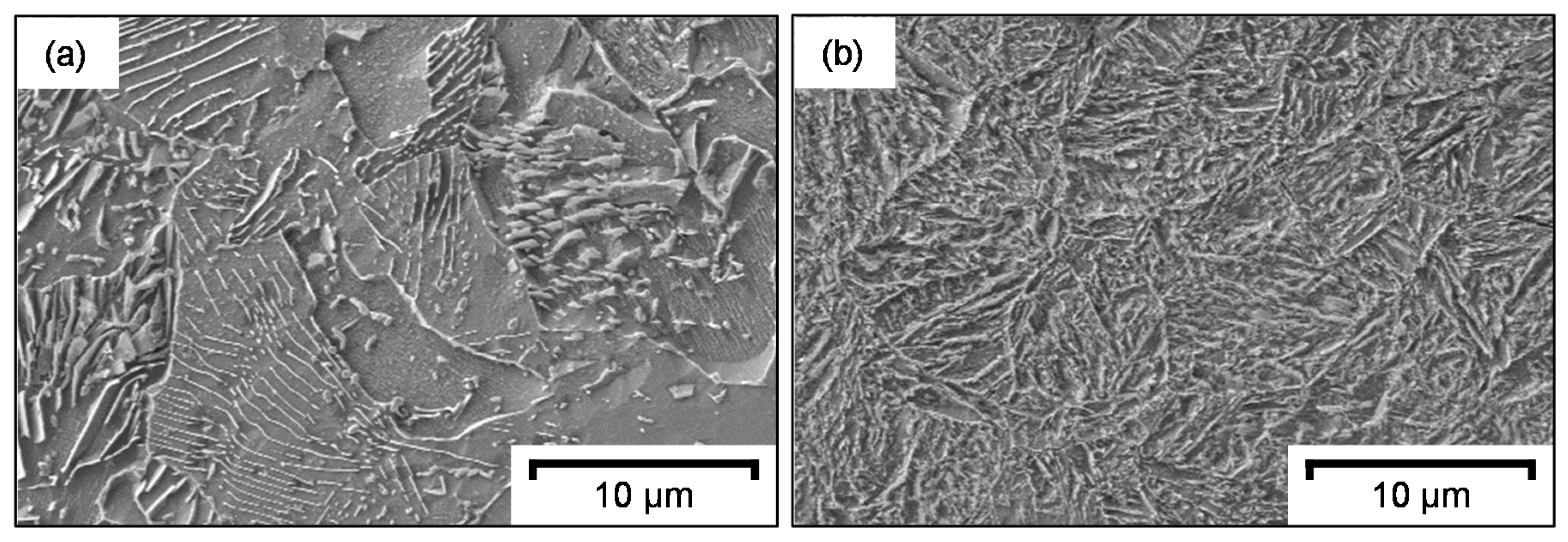

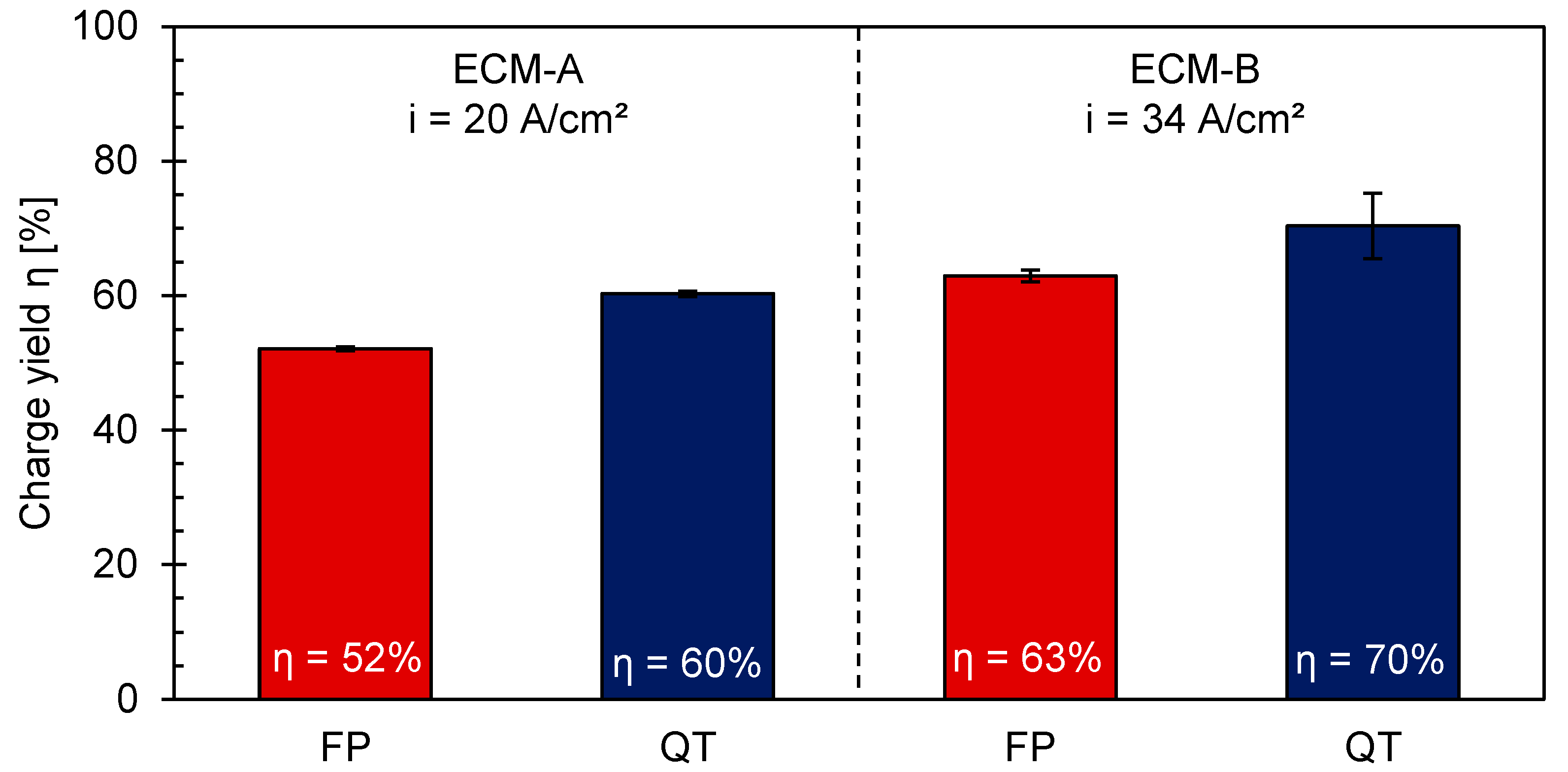
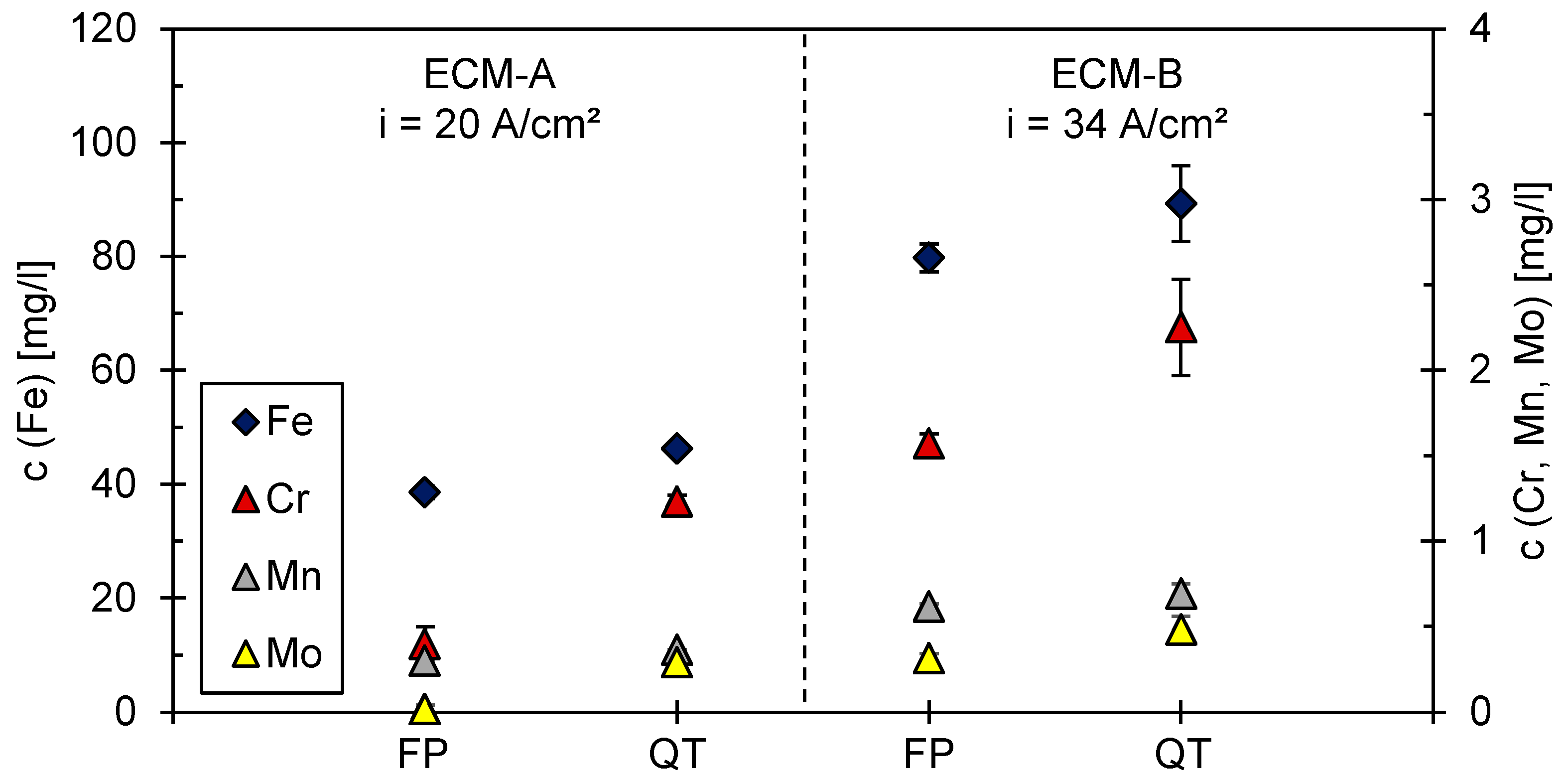
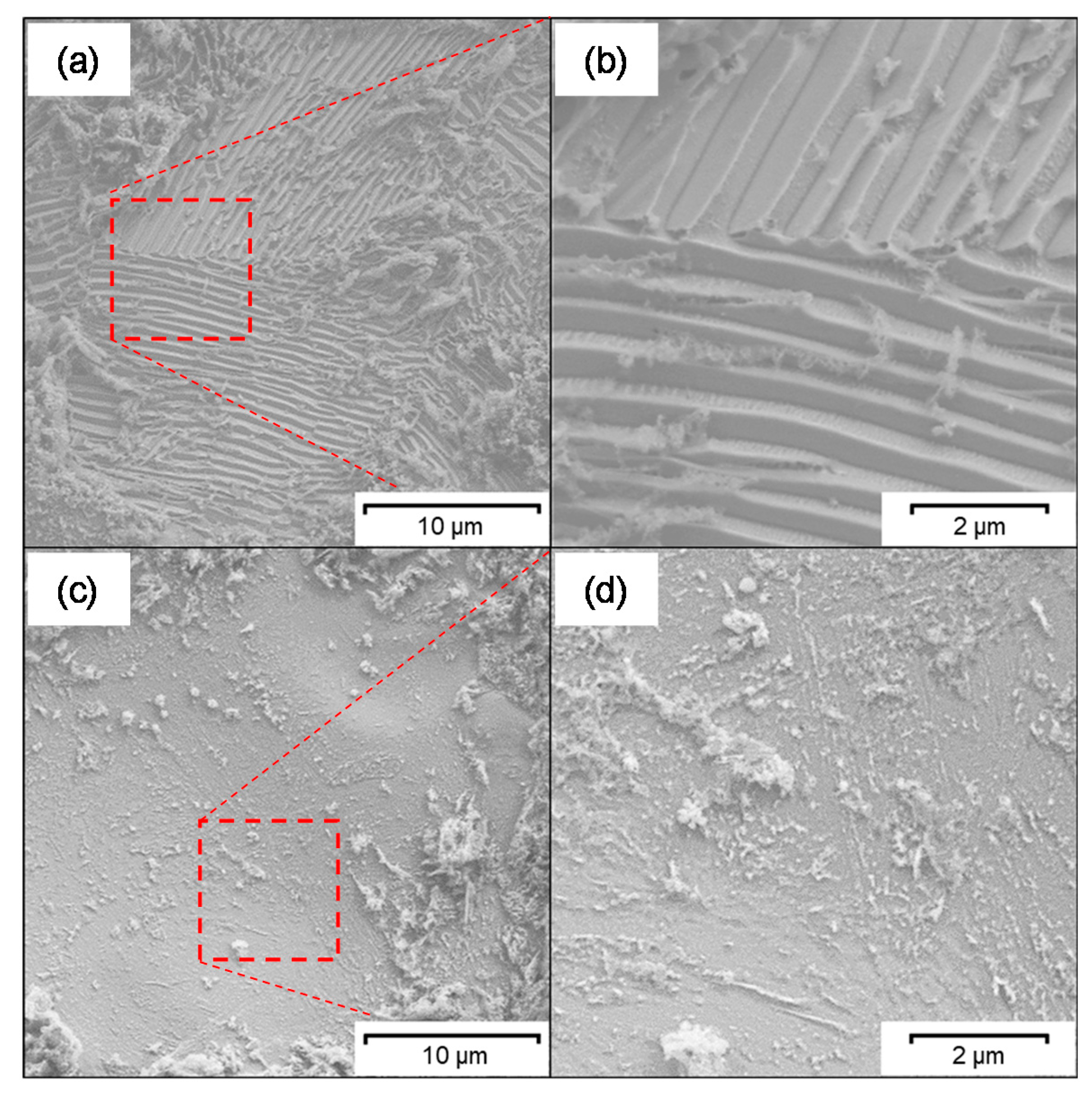
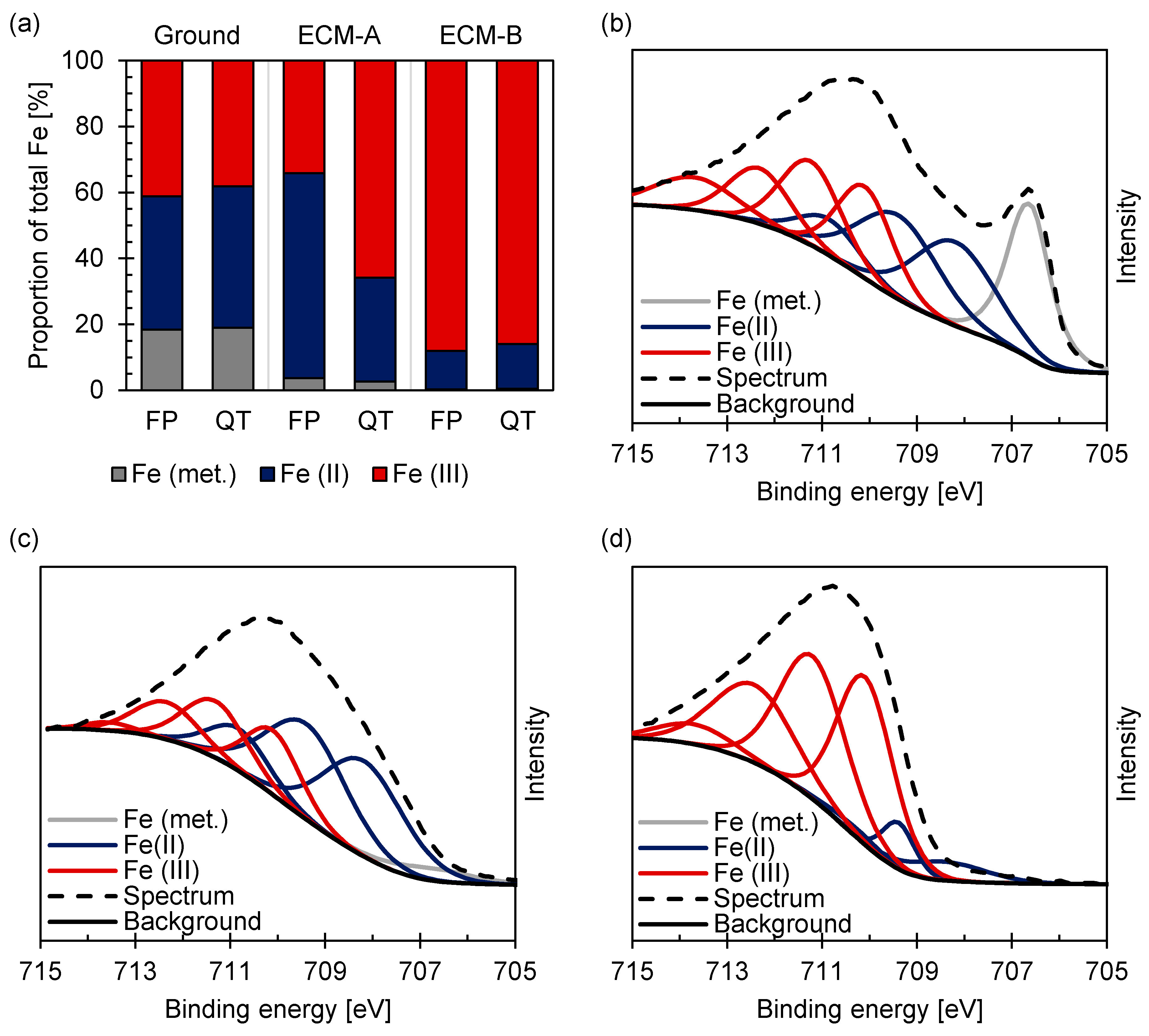

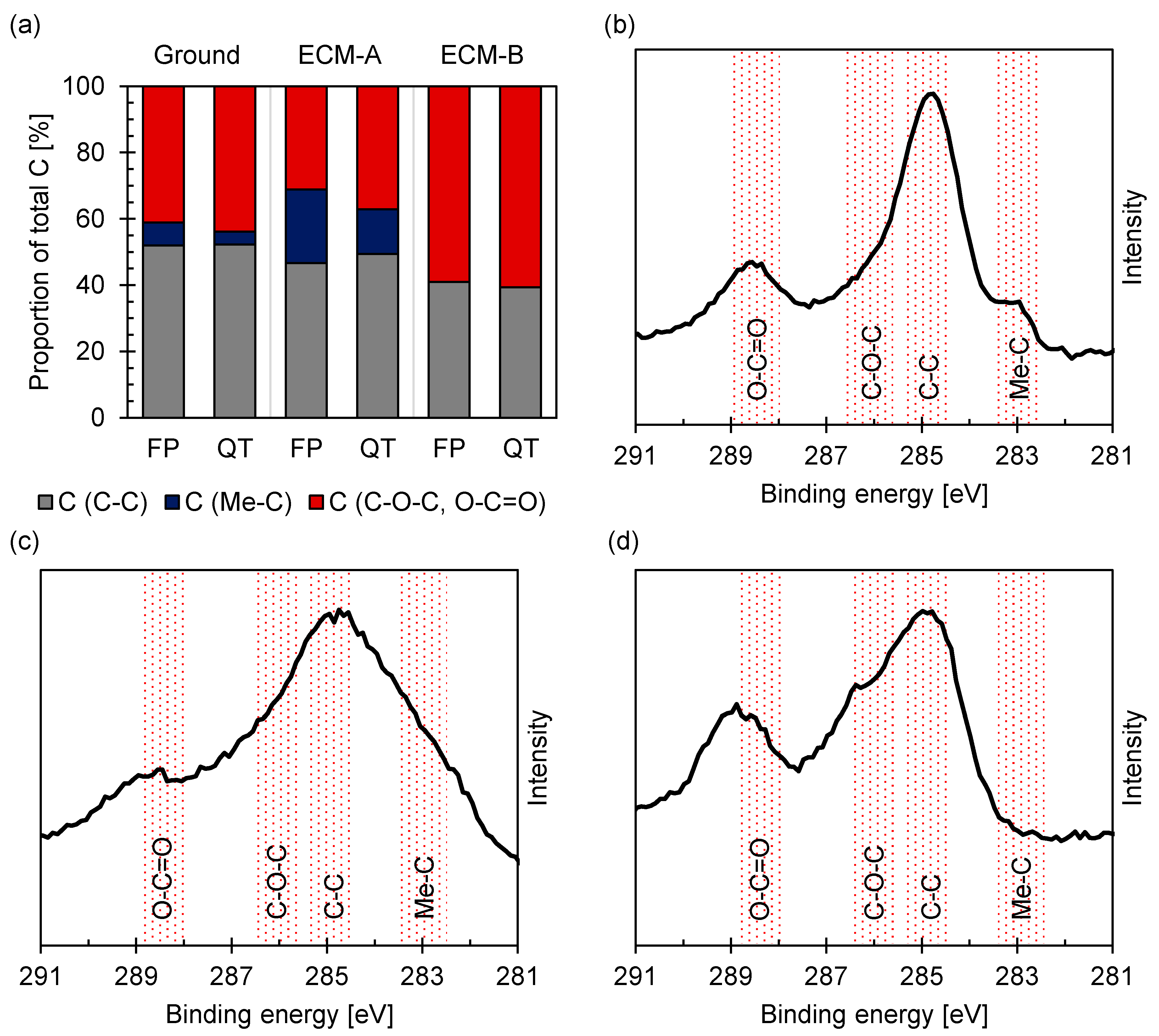
| Element | wt.% | at.% |
|---|---|---|
| C | 0.43 | 1.96 |
| Si | 0.26 | 0.51 |
| Mn | 0.74 | 0.74 |
| P | 0.01 | 0.018 |
| S | <0.001 | <0.002 |
| Cr | 1.09 | 1.15 |
| Mo | 0.25 | 0.14 |
| Fe | Bal. | Bal. |
| Process | Initial Working Gap [µm] | Feed Rate Cathode [mm/min] | Machining Time [s] |
|---|---|---|---|
| ECM-A | 1000 | 0.1 | 100 |
| ECM-B | 500 | 0.6 | 33.3 |
| Process | Removal Rate Calculated by Height Measurement [mg/(s *cm2)] | Removal Rate Calculated from Electrolyte by ICP-MS [mg/(s *cm2)] | Idealized Removal Rate Calculated by Faraday’s Law [mg/(s *cm2)] |
|---|---|---|---|
| FP ECM-A | 2.4 ± 0.1 | 3.0 ± 0.1 | 5.8 ± 0.1 |
| QT ECM-A [21] | 2.8 ± 0.4 | 3.6 ± 0.1 | 5.9 ± 0.1 |
| FP ECM-B | 4.9 ± 0.8 | 6.2 ± 0.2 | 9.8 ± 0.2 |
| QT ECM-B [21] | 5.3 ± 1.1 | 7.0 ± 0.5 | 9.8 ± 0.1 |
| Surface | Fe [wt.%] | Cr [wt.%] | Mo [wt.%] | O [wt.%] | C [wt.%] |
|---|---|---|---|---|---|
| FP ground | 55.0 | 1.5 | 0.4 | 32.1 | 11.0 |
| QT ground | 51.9 | 1.0 | 0.3 | 31.4 | 15.5 |
| FP ECM-A | 44.0 | 2.3 | 0.5 | 45.1 | 8.0 |
| QT ECM-A | 47.4 | 2.6 | 0.4 | 42.9 | 6.6 |
| FP ECM-B | 45.2 | 2.1 | 0.6 | 46.8 | 5.4 |
| QT ECM-B | 43.6 | 2.5 | 0.4 | 46.7 | 6.8 |
Publisher’s Note: MDPI stays neutral with regard to jurisdictional claims in published maps and institutional affiliations. |
© 2021 by the authors. Licensee MDPI, Basel, Switzerland. This article is an open access article distributed under the terms and conditions of the Creative Commons Attribution (CC BY) license (https://creativecommons.org/licenses/by/4.0/).
Share and Cite
Schupp, A.; Beyss, O.; Rommes, B.; Klink, A.; Zander, D. Insights on the Influence of Surface Chemistry and Rim Zone Microstructure of 42CrMo4 on the Efficiency of ECM. Materials 2021, 14, 2132. https://doi.org/10.3390/ma14092132
Schupp A, Beyss O, Rommes B, Klink A, Zander D. Insights on the Influence of Surface Chemistry and Rim Zone Microstructure of 42CrMo4 on the Efficiency of ECM. Materials. 2021; 14(9):2132. https://doi.org/10.3390/ma14092132
Chicago/Turabian StyleSchupp, Alexander, Oliver Beyss, Bob Rommes, Andreas Klink, and Daniela Zander. 2021. "Insights on the Influence of Surface Chemistry and Rim Zone Microstructure of 42CrMo4 on the Efficiency of ECM" Materials 14, no. 9: 2132. https://doi.org/10.3390/ma14092132
APA StyleSchupp, A., Beyss, O., Rommes, B., Klink, A., & Zander, D. (2021). Insights on the Influence of Surface Chemistry and Rim Zone Microstructure of 42CrMo4 on the Efficiency of ECM. Materials, 14(9), 2132. https://doi.org/10.3390/ma14092132






